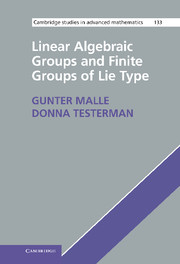Book contents
- Frontmatter
- Contents
- Preface
- List of tables
- Notation
- PART I LINEAR ALGEBRAIC GROUPS
- PART II SUBGROUP STRUCTURE AND REPRESENTATION THEORY OF SEMISIMPLE ALGEBRAIC GROUPS
- PART III FINITE GROUPS OF LIE TYPE
- Appendix A Root systems
- Appendix B Subsystems
- Appendix C Automorphisms of root systems
- References
- Index
PART I - LINEAR ALGEBRAIC GROUPS
Published online by Cambridge University Press: 05 June 2012
- Frontmatter
- Contents
- Preface
- List of tables
- Notation
- PART I LINEAR ALGEBRAIC GROUPS
- PART II SUBGROUP STRUCTURE AND REPRESENTATION THEORY OF SEMISIMPLE ALGEBRAIC GROUPS
- PART III FINITE GROUPS OF LIE TYPE
- Appendix A Root systems
- Appendix B Subsystems
- Appendix C Automorphisms of root systems
- References
- Index
Summary
In this part we introduce the main objects of study, linear algebraic groups over algebraically closed fields.
We assume that the reader is familiar with basic concepts and results from commutative algebra and algebraic geometry. More specifically, the reader should know about affine and projective varieties, their associated coordinate ring, their dimension, the Zariski topology, and basic properties thereof.
In Chapter 1 we define our main objects of study. The examples which will guide us throughout the text are certain subgroups or quotient groups of the isometry group of a finite-dimensional vector space equipped with a bilinear or quadratic form. We state the important result which says that any linear algebraic group is a closed subgroup of some group of invertible matrices over our fixed field, which is nearly obvious for all of our examples (the proof will be given in Chapter 5). In Chapter 2, we show that the Jordan decomposition of a matrix results in a uniquely determined Jordan decomposition of elements in a linear algebraic group. This in turn gives us the notion of semisimple and unipotent elements in these groups. We establish the important result that any group consisting entirely of unipotent elements is conjugate to a subgroup of the upper unitriangular matrices.
Chapter 3 is devoted to the structure theory of commutative linear algebraic groups. In particular, Theorem 3.1 focuses attention on groups consisting entirely of unipotent elements or of semisimple elements. Theorem 3.2 classifies the connected one-dimensional linear algebraic groups.
Information
- Type
- Chapter
- Information
- Publisher: Cambridge University PressPrint publication year: 2011
Accessibility standard: Unknown
Why this information is here
This section outlines the accessibility features of this content - including support for screen readers, full keyboard navigation and high-contrast display options. This may not be relevant for you.Accessibility Information
- 1
- Cited by
